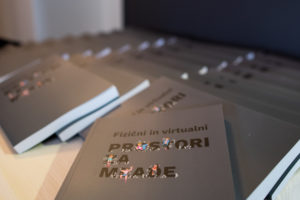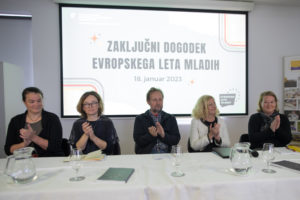On Wednesday, January 18th, the closing event of the European Year of Youth took place, organized by the Office of the Republic of Slovenia for Youth.
 The event celebrated the past year’s achievements, presented examples of good practices, and promoted the printed edition of the Spaces for Youth (Prostori za mlade) book, which includes numerous examples of physical and digital spaces of youth organizations in Slovenia. In addition to descriptions of our spaces, we also prepared a contribution titled “Digital Spaces: From Spaces of Listening to Spaces of Creation and Initiative” (article in Slovene).
The event celebrated the past year’s achievements, presented examples of good practices, and promoted the printed edition of the Spaces for Youth (Prostori za mlade) book, which includes numerous examples of physical and digital spaces of youth organizations in Slovenia. In addition to descriptions of our spaces, we also prepared a contribution titled “Digital Spaces: From Spaces of Listening to Spaces of Creation and Initiative” (article in Slovene).
A roundtable discussion on the importance of spaces for young people was organized as part of the book’s presentation. Sabina Belc, leader of the Creative Digital Spaces project at the Socialna akademija, participated in the roundtable discussion alongside Tina Kosi, the Acting Director of the Office of the Republic of Slovenia for Youth, Milko Poštrak from the Faculty of Social Work, Katarina Gorenc, the Head of the Youth Office of the City Municipality of Ljubljana, and Maja Hostnik, the Director of the Mreža MaMa. They explored the significance of the existence and investment in spaces for young people, as well as the potential of digital spaces.
Maja Hostnik explained that civic spaces for young people were chosen as a topic in the 8th cycle of the European Youth Dialogue during the presidencies of Germany, Portugal, and Slovenia in the Council of the European Union.
Tina Kosi stated that spaces for young people have not been widely discussed because they were taken for granted. She added that the Spaces for Youth book is an excellent opportunity to bring spaces for young people back to the forefront. In response to these statements, a participant highlighted that there hasn’t been an infrastructure call for several years that would allow organizations to address the challenges described in the book and called for reflection.
 Subsequently, Milko Poštrak summarized the development of youth spaces over time, while Katarina Gorenc presented the key milestones in the development of youth centers in Ljubljana and described the opportunities that arise with the creation of a new youth center in Cukrarna.
Subsequently, Milko Poštrak summarized the development of youth spaces over time, while Katarina Gorenc presented the key milestones in the development of youth centers in Ljubljana and described the opportunities that arise with the creation of a new youth center in Cukrarna.
Sabina Belc discussed the potential of virtual spaces for young people, through which youth workers could reach groups of young people who had not previously participated in physical spaces for young people, especially during the COVID-19 pandemic. She emphasized that for efficient work in virtual spaces, youth workers must feel comfortable in them, highlighting the importance of exploring new technologies and ensuring their education and development of necessary digital competencies.
You can read the official reports of the closing conference in Slovene on mlad.si (here).
Browse the digital publication here.
Author of the photos: Matej Pušnik, Office of the Republic of Slovenia for Youth and DALL-E from Open AI
